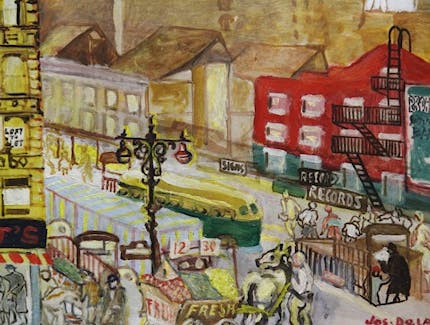Joseph Samuel Delaney
1904 - 1991

Joseph Samuel Delaney
1904 - 1991
African-American artist Joseph Delaney was a folk-expressionist painter who loved New York City, both as a subject for painting and the spectacle and experience of ever-changing life and vitality. Of the city, he said: "The curtain goes up on the stage of life every time we walk into the street. In spite of New York's being the most congested city I have been in, and know about, by and large, it's just people on the move. I have enjoyed more than I can say seeing people and hearing them speak about things they love and enjoy."
Delaney, the son of a Methodist minister, was born in Knoxville, Tennessee, in 1904, the ninth of ten children. It was in church that Delaney and his older brother, Beauford, began to express their art talent by drawing on Sunday School cards. He attended school there, leaving the Knoxville Colored High School at the end of the ninth grade. The next few years were spent doing odd jobs around town (caddy at the Cherokee Country Club, bell hop at the Farragut Hotel) until leaving for Chicago around 1924, where he served three years with the National Guard. He returned to Knoxville in 1929, selling insurance and helping found the city's first black Boy Scout unit.
In 1930, Delaney went to New York City, studying at the Art Students League with Thomas Hart Benton, George Bridgman and Alexander Brooke. Other students there at the time included Jackson Pollock, Henry Stair, and Bruce Mitchell.
In 1932, he exhibited in the first Washington Square Outdoor Art Show. He would continue to do so for the next forty years, working as a sketch artist there, drawing such celebrities as Eartha Kitt, Arlene Francis, Eleanor Roosevelt, and Tallulah Bankhead. Delaney would spend fifty-six years living and painting in the area of lower Manhattan, SoHo and Union Square.
From 1934-1940, Delaney worked for the WPA (Works' Progress Administration) on projects in New York City including the Index of Design for the Metropolitan Museum of Art, the Pier 72 mural, and the Story of the Recorded Word mural at the Public Library. He also taught at Harlem and Brooklyn settlement houses and the Art Students League while exhibiting his paintings in his studio, art galleries and other exhibitions.
In 1942, Delaney received a Julius Rosenwald grant of $1200.00 to travel, sketch and later paint the Eastern seaboard. In 1964, he was a sketch artist for the New Orleans exhibit and later the Ghana exhibit at the New York City World's Fair. From 1978-1980, he worked for CETA, the Comprehensive Employment and Training Act, as an artist in residence at the Henry Street Settlement.
In 1979, Delaney's brother, Beauford, died in Paris at St. Anne's Hospital, an insane asylum. Delaney paid over $6,000 to the French government for taxes, storage, and shipping, to have Beauford's art and personal effects shipped to the U.S.
The University of Tennessee would figure strongly in Delaney's life. In 1970, the artist had an exhibition there, and his painting, "V-J Day, Times Square", was added to their collection. In 1986, the Ewing Gallery exhibited, "Joseph Delaney: A Retrospective," as part of the Homecoming '86 Festival. In that year, author Alex Haley helped Delaney become an artist-in-residence at The University of Tennessee, Knoxville, a position he would hold until his death on Wednesday, November 21, 1991, at The University of Tennessee Medical Center.

